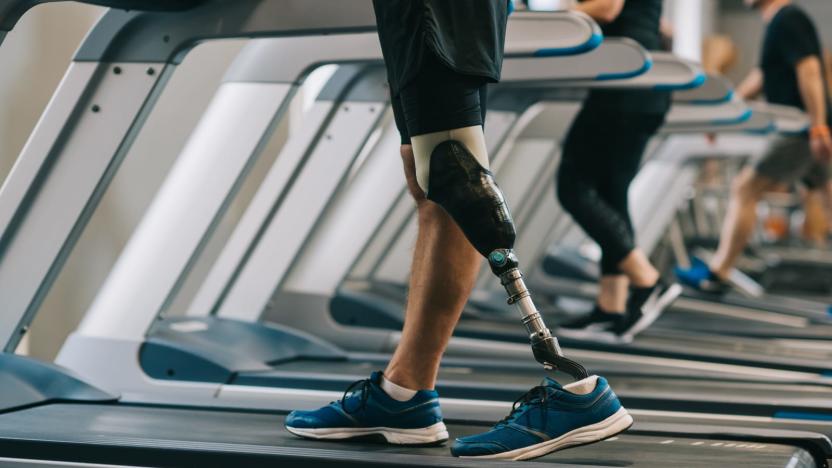ETH Zurich
Latest

Switzerland pilots a contact tracing app using Apple and Google's tech
Switzerland is piloting a COVID-19 contact tracing app that uses the Apple-Google framework.

This machine keeps transplant livers alive for a week
With current technology, a human liver donated for transplant can only be kept alive for 24 hours, and often, if the liver is damaged or diseased, it cannot be considered for transplant. That could soon change. Liver4Life has developed a liver perfusion machine that can preserve injured human livers for one week and can even repair damage.

New prosthetic legs let amputees feel their foot and knee in real-time
There's been a lot of research into how to give robots and prosthesis wearers a sense of touch, but it has focused largely on the hands. Now, researchers led by ETH Zurich want to restore sensory feedback for leg amputees, too. In a paper published in Nature Medicine today, the team describes how they modified an off-the-shelf prosthetic leg with sensors and electrodes to give wearers a sense of knee movement and feedback from the sole of the foot on the ground. While their initial sample size was small -- just two users -- the results are promising.

Researchers say 'spidey senses' could help self-driving vehicles avoid hazards
Researchers want to give cars, planes and drones "spidey senses." That is, they want to give autonomous machines sensors that mimic nature. In a paper published in ACS Nano, a team of researchers -- from Purdue University, Nanyang Technological University in Singapore and ETH Zürich -- propose integrating spider-inspired sensors into the exterior of autonomous machines. Doing so, they say, would allow vehicles to selectively process data faster than currently possible.

Six machines that build a better world
By Cat DiStasio When it comes to construction, technology can go a long way toward making building projects faster, more economical and safer. Robots that can alleviate back-breaking manual labor and cut down on injuries are a welcome addition to work sites, and they can do everything from building a brick home to constructing a steel bridge. Other cool machines have been engineered to help those in need, like a 40-foot-tall 3D printer that makes mud houses for developing nations. With so many complicated tasks in the construction world, it's amazing to think about how machines can help us do them better, more powerful and often more eco friendly.

Heroes in a half shell: autonomous robot sea turtles in development
Sure you could have a robot assist you around the home, or even one that'll make factories friendlier, but we'll opt for a robot sea turtle any day of the week. The Swiss folks over at ETH Zurich are working on making that a reality with the Naro-Tartaruga, a turtle-inspired machine that would swim efficiently while carrying cargo in its shell. It's currently a cylindrical aluminum vessel with a couple of flippers, but concept designs include that totally bad-ass bot in the image above. The turtle-bot has a top speed of over 7 knots, so it'll handily beat any real sea turtle in a race, and the big torso has enough space for battery and sensors that are necessary for autonomous function. The fins on the turtle have a fully three-dimensional mechanism -- there are three actuators per fin, and each actuate the fin axle independently. The end goal is for the development of underwater autonomous vehicles, which will hopefully bring us one step closer to SeaQuest DSV. In the meantime, we'd like one just so we can freak the hell out of our cats.

IBM creates consistent electron spin inside semiconductors, takes spintronics one twirl closer
A fundamental challenge of developing spintronics, or computing where the rotation of electrons carries instructions and other data rather than the charge, has been getting the electrons to spin for long enough to shuttle data to its destination in the first place. IBM and ETH Zurich claim to be the first achieving that feat by getting the electrons to dance to the same tune. Basing a semiconductor material on gallium arsenide and bringing the temperature to an extremely low -387F, the research duo have created a persistent spin helix that keeps the spin going for the 1.1 nanoseconds it would take a normal 1GHz processor to run through its full cycle, or 30 times longer than before. As impressive as it can be to stretch atomic physics that far, just remember that the theory is some distance from practice: unless you're really keen on running a computer at temperatures just a few hops away from absolute zero, there's work to be done on producing transistors (let alone processors) that safely run in the climate of the family den. Assuming that's within the realm of possibility, though, we could eventually see computers that wring much more performance per watt out of one of the most basic elements of nature.

Robot uses glue gun to make tools, hopes to ace Survival Skills 101
Looking through Engadget's annals of robotic achievements, we see droids juggling, dabbling in competitive sailing and even manning prisons. Cool as they are, those functions aren't going to mean a thing when Mr. Automaton is lost in the wilderness, damaged and without a helping human hand in sight. Researchers at ETH Zurich are working to change that scenario, as they're currently developing a "self-reconfigurable" device that packs a glue gun for creating the tools it needs on the fly. It might not be the quickest method -- as you'll see in the video below, making a glue cup takes a good hour -- but it's effective enough for transporting and pouring water. That's not to say that the prototype is ready to fend for itself; it built the cup, but only under human direction. The researchers' next step is adding in autonomous capabilities so the bots can repair things -- and even build other robots -- without being told to do so. A sea of self-regenerating droids? Sounds harmless to us.

Research shocker! Keyless car entry systems can be hacked easily, elegantly
We know you are vigilant enough not to trust your car's security to a wireless system, but plenty of other folks like the convenience of putting away the metallic keys and getting into their vehicles with a bit of Bond-like swagger. Professor Srdjan Capkun of ETH Zurich found himself perched on the fence between these two groups when he recently purchased a vehicle with a keyless entry system, so he did what any good researcher would: he tried to bypass its security measures. In total, he and his team tested 10 models from eight car makers and their results were pretty conclusive: each of the tested vehicles was broken into and driven away using a very simple and elegant method. Keyless entry systems typically work by sending a low-powered signal from the car to your key fob, with the two working only when they're near each other, but the wily Zurich profs were able to intercept and extend that signal via antennas acting as repeaters, resulting in your key activating your car even when it's nowhere near it. The signal-repeating antennae have to be pretty close to both the key and the car, but that's why heist movies stress the importance of teamwork. Hit the source link for all the chilling details.

Cyborg flies jack into Lego robots semi-Avatar-style
See that? It's a picture of a fly that thinks it's flying around, but it's really navigating a Lego car around a small obstacle course. Researchers at ETH Zurich's Institute of Robotics and Intelligent Systems developed an impressive visual stimulus tube that tricks said fly into thinking it's navigating the same terrain the camera-mounted robot is in. Then--in a novel twist--a high-speed visual wing-tracking system tells the robot where to roam, based on where the fly thinks it's flying. While it's not exactly what the Na'vi were dealing with, it's close enough to make us a fun combination of fascinated and scared. Pseudo-psychedelic fly stimulus video after the break.

Microsoft unveils Barrelfish multi-core optimized OS
With current operating systems, as the number of cores increases efficiency decreases. Microsoft Research has just announced an experimental OS, called Barrelfish, that they're developing in conjunction with ETH Zurich, in the hopes that they'll learn how to buck that trend -- both with current and future hardware. Building upon lessons learned with projects including Midori and Singularity, Barrelfish eschews share memory schemes in favor of message passing and a kind of database that shuttles information between cores. Heady stuff, for sure -- but just the kind of thing that sets off our Geek Alarms. If you can't wait to check this one out for yourself, hit the read link for the first release snapshot, in all its Open Source glory. The rest of us will probably remain content waiting to see how this new-found knowledge will trickle down to Windows 7 users in the future. [Via DailyTech]





